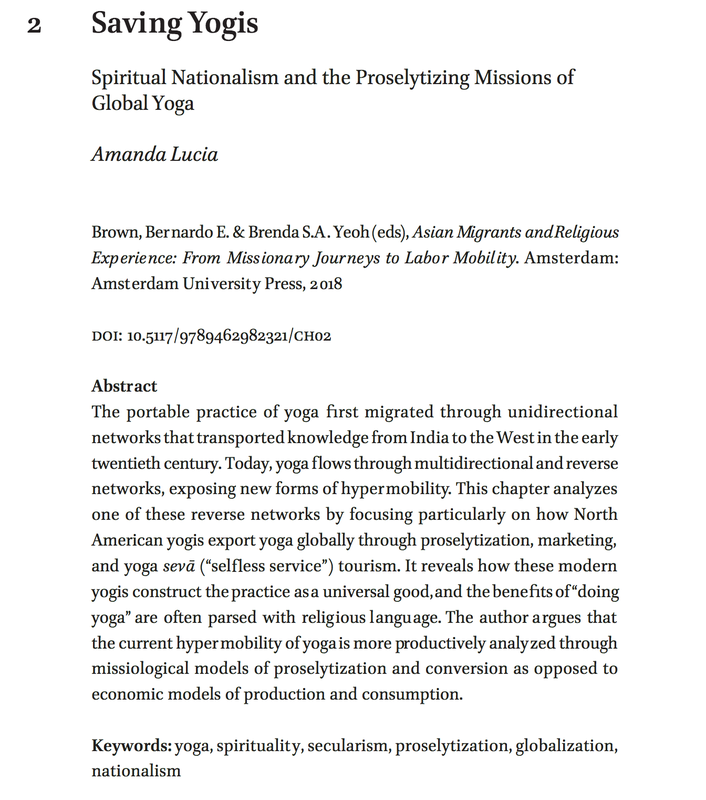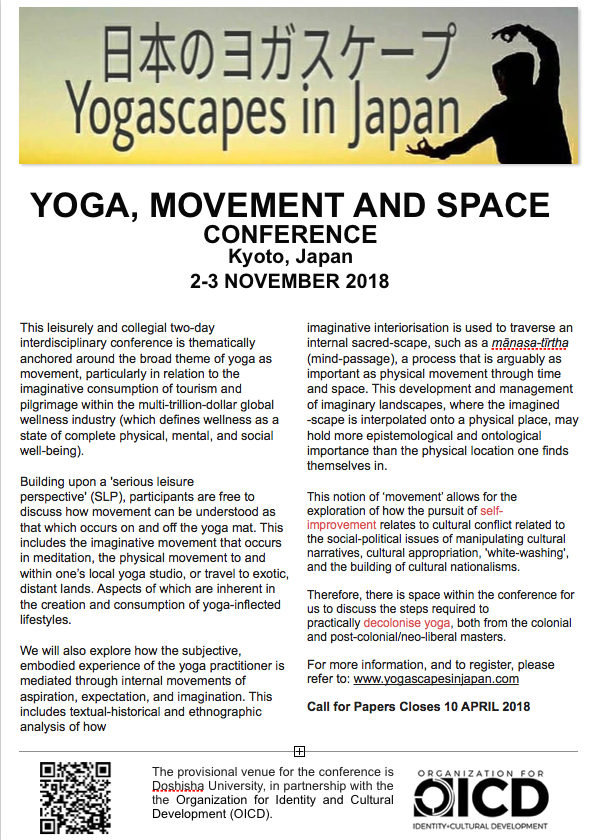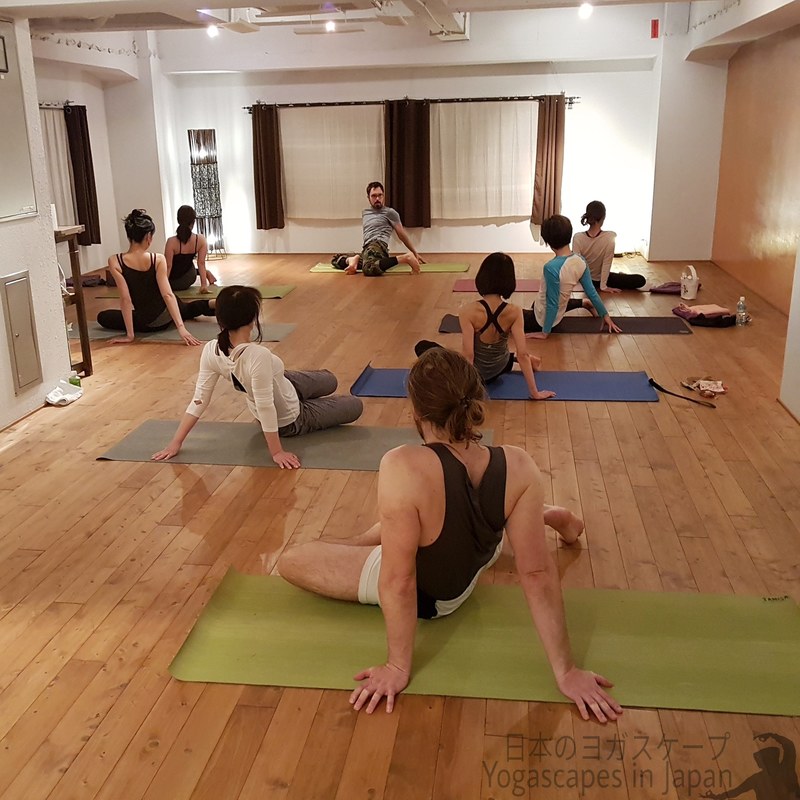|
I've started to write a series on yoga called Autobiography of a Bhogi: Adventures in Yogaland - you can find the first instalment here.
Happy Travels. Om voyage...
0 Comments
28/3/2018 0 Comments We are back!This post is non-yoga-related; however, Aimee said she "reached enlightenment" after only 10 mins in the main temple!!! ____________________________________________________________________________________________________________________________________________________ Your mind is nirvana, I'll meet you there 💛 After lunch, I strolled to a local temple close to university. It is known as Hyakumanben-Chionji Temple. The temple is over 500 years old. I went in to the main temple and greeted the priest Nagase, who educated me on the history of the temple, Hyakumanben-Dainenjyu-Kuri. He also told me about the Juzu beads, which are believed to be the largest in the world, and weigh in at 320kgs and are 110m long. I was fascinated by the Juzu beads upon entering the temple. They decorate the inside of the main temple, draping from the ceiling, around the walls and pillars. Unfortunately, no cameras are allowed inside, so you will have to experience it for yourself when you come visit Kyoto. The large grounds of the temple also host a monthly flea market on the 15th. Also, daily chanting is offered at 6:30am, 11:00am and 4:00pm. 27/3/2018 0 Comments nearly there...There is nothing like a 01:30 finish to get that paper submitted to the publisher before the deadline. There was an email that went missing and I never got the response from the editor, until quite late, and to get the paper into this edition meant I've done some serious burning of a few different oils to get it sent off on time - I'm looking forward to seeing this article published soon in the next BULLETIN of the Nanzan Institute for Religion & Culture. Here is the last volume published - like the last edition, the upcoming one will also be free via open access.
If you are curious, the title of the paper is: Śāntamūrti: The Legitimate Disposition(s) of the ‘Temple of Peace’ Social Network Here is an overview of the paper: This paper provides a typology of the various groups identified within the social network of the Shanti Mandir, ‘Temple of Peace’ organisation. This new religious movement was founded in 1987 by the current spiritual head, Swami Nityananda Saraswati. The social network consists of thousands of people spread throughout a global network of devotees. I first met Nityananda in 1998, when he visited Australia. Since that time, I have been a casual interloper and visitor to his ashram. During multiple visits, between 2006 and 2013, I conducted more than 12-months of ethnographic fieldwork in the organisation’s main ashram, which is located on the west coast of India, near the city of Valsad, Gujarat. I met many people from all across the globe, who came to explore and consume a particular neo-Hindu spirituality and establish an internal definition of self, which is based on the ‘authentic’ and ‘legitimate’ yogic identity promoted by Shanti Mandir (See JENKINS 2008:12). In this paper, I begin by asking the following question: What makes the groups different? I answer this question through employing Legitimation Code Theory’s first analytical dimension, namely, Specialisation. This is done to identify the various ways in which the symbolic exchanges of capital between the groups occur, how the internal nature of the competition for status and recognition determines legitimate participation, and how the distinct hierarchies operate based on observations of the spatial and gendered relations between the groups. This research demonstrates that the hierarchic structure of the network is not linear, but, instead can be seen more like a three-sided pyramid, with each group working interdependently to support the guru’s mission, yet engaging in intra-group competitions for status and symbolic resources. 21/3/2018 0 Comments great article by amanda luciaI've been patiently waiting to read Amanda Lucia's work on yoga festivals. Just yesterday Amanda has uploaded this great article - it's worth reading - You can download from the link or get the file here. Here is a screen shot of the front page.
11/3/2018 0 Comments 4-week yoga course looks goodCourse SummaryOver the past 2,500 years, yoga has evolved from a way of transcending the world to a multi-billion-dollar industry. But where did its practices come from and what was their purpose? How has that changed as traditions transform? Are there common ideas that make practices yogic? If so, are they relevant to modern practitioners?
This four-week course puts contemporary yoga into context, with an insightful and engaging overview of history and philosophy. From the Vedic Upaniṣads, via the Bhagavad Gītā and Yoga Sūtra, to more recent texts on haṭha yoga, we will trace the main themes in yogic teachings, and look at some less commonly studied sources. Accessible and fun, combined with academic depth, the course explores the latest scholarly findings. Daniel Simpson earned his Master’s degree at SOAS, University of London, where he studied with several of the foremost researchers of yoga history. He is also a devoted practitioner, and approaches the subject from this perspective. About Your TeacherDaniel Simpson has been studying yoga in various forms since his first trip to India in the 1990s. He holds an M.A. in Traditions of Yoga and Meditation (from SOAS in London), and teaches courses on yoga philosophy for the Oxford Centre for Hindu Studies. His presentations combine practical experience with the latest research from academia, drawing on his skills as a former reporter to make complex subjects clear and interesting. He also writes about yoga for magazines and on his website: http://danielsimpson.info. http://embodiedphilosophy.courses/briefhistory?sc_ref=5oa8YyiFVDL7K1Qu
I decided to make a conference QR code and added it to the poster. You can share the QR code and conference flyer, as well as download :-)
外傷治療のヨガのマップ
This map is another work in progress, which visually represents many places around the world that offer trauma-sensitive or trauma-informed yoga therapy / classes. I was interested to see how these concepts were spatially arranged, and in which countries these ideas were more prevalent. This helps us to see which cultures value an evolved understanding of the way in which yoga can work therapeutically. 私のウェブサイトをご覧ください
Please consider contributing to #yoga research by completing this 5-min survey - It's available in both English and Japanese. You don't have to be in Japan to complete it. It's really shareable with yoga buddies and students ;-) https://www.yogascapesinjapan.com/yoga-survey.html Dear Friends,
The Call for Papers for the Yoga, Movement and Space Conference is now released. The conference will be held in Kyoto, Japan over 2 days from 2-3 November 2018. The provisional venue is Doshisha University. The website also contains background information about the conference, how to register and confirm payment, as well as other travel-related issues. Thank you, for your interest in the conference. Please, feel free to ask any questions. Patrick Last Friday evening, I was lucky enough to attend David France's class at Tamisa Yoga.
I am quite often spent after a long week at work. I always like the idea of going to a yoga class on a Friday evening, so that I can kick off the weekend in a nice way. Sure, sometimes, I don't mind going straight to a bar, and saving the yoga for another day. Quite often, I am still at work after 9pm... but yoga, on a Friday night is good. It's something that I aspire towards. I had met David, briefly, the week before. I was looking forward to his class, even though I was really tired. I could have been happy with just starting, staying and finishing in shavasana..., but David had none of that. It said on the timetable 'Vinyasa 2'. I guessed, from this title, that it would be a level 2 Ashtanga Vinyasa flowy-like class. It wasn't. Well, not in the way I thought it would be. Instead, David turned the idea of a vinyasa upside down, at least for me. Without much ado, after a brief warm up session, we started working with what David called the 'cossack squat'. I later found out it was something that he had recently come across on Instagram. However, it was clear, by the depth of thought, and our lunges/squats he took us into, that he had seriously thought about, not just the workout this would give us, but also, an earnest enquiry into the bio-mechanics of moving into and through these movements. The class, then, was anchored by this cossack squat, which, as I told him after the class, is one move that I am, more or less terrified off. I avoid it. Simply because I don't have the best knees in the world. But, David helped me work through these fears. He offered insightful adjustments and alternatives, based on a variety of skill levels, experience and confidence. We finished the 90 minute class with a lengthy, quiet shavasana, which was ended by a few quick trills of some bells. I'm looking forward to my next class with David. I think, also, that he's running another 1-day workshop in Osaka, soon. You should contact him, if you want, to find out more about it. |
CategoriesArchives
November 2019
|
||||||||||||
 RSS Feed
RSS Feed



